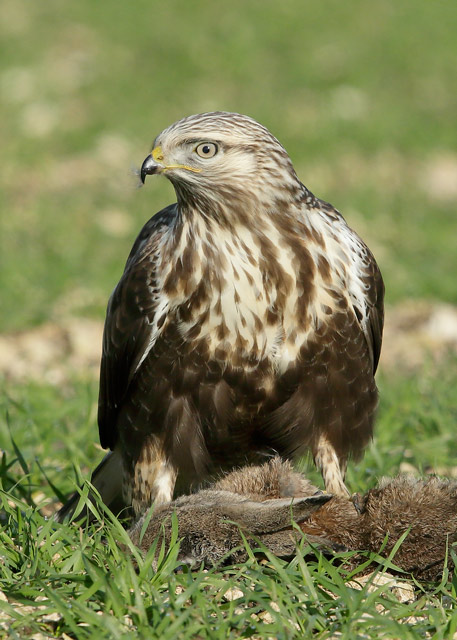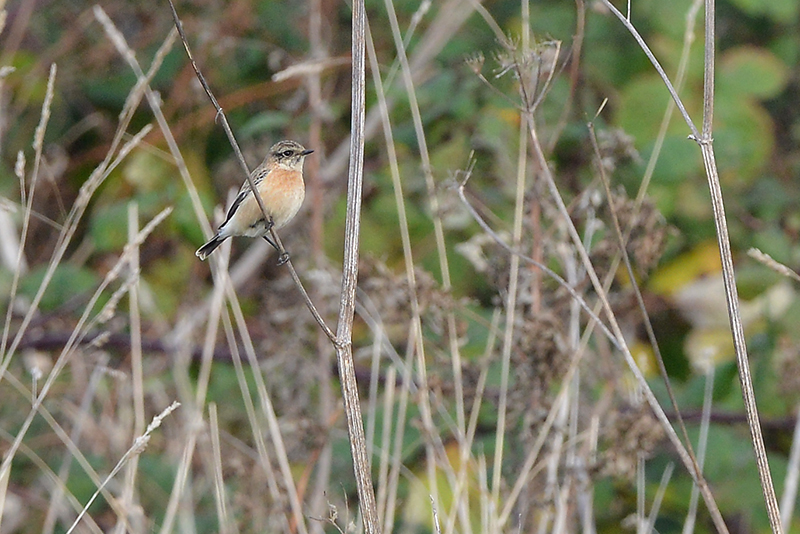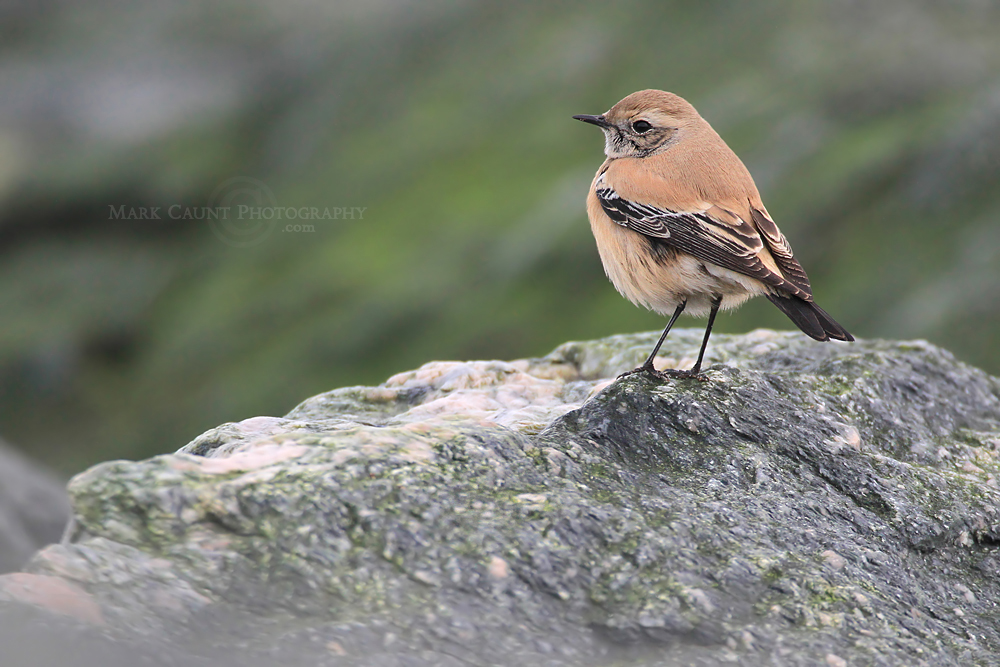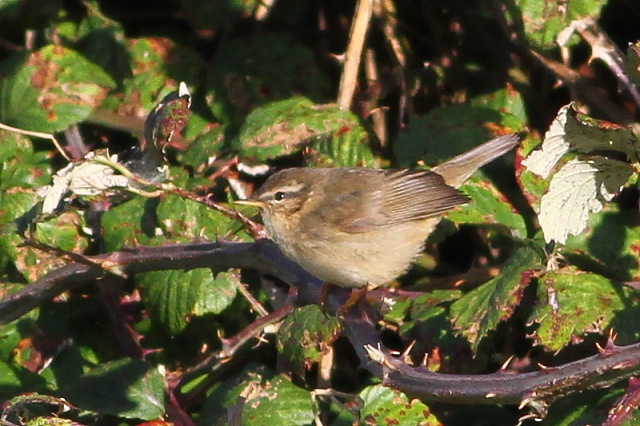The week at a glance
- Little Bustard briefly touches down in Dorset
- Another American Coot, this time in the Outer Hebrides
- ...while the bird in Co Kerry remains
- Blyth's Pipit in Pembrokeshire
- Black Stork in Essex and Suffolk
- Desert Wheatear in Angus
A fairly eventful mid-November week produced some fine birds seen among the gradually diminishing volume of reports on Bird News Extra. The highlight was undoubtedly Britain's first Little Bustard for twelve years, seen for a matter of minutes at West Bexington, Dorset, on 18th. Though photographed, the bird soon flew off inland and was not seen for the rest of the day despite a reasonably extensive search by a small gathered crowd. For the last twitchable record one has to head back as far as late October 1996, when a bird spent four days on The Lizard, Cornwall. This week's bird follows a good run of records on the near-continent with a bird in the Netherlands in February followed by summer records from Finland and Norway (3) and, most recently, a late October occurrence in Germany. Though re-finding the Dorset bird may seem like the proverbial needle in a haystack, their conspicuousness in flight at least may yet give away its presence once more — here's hoping so. Coincidentally, a Great Bustard on Alderney, Channel Islands, on 17–18th represents the first to be seen there in modern times although the Salisbury Plain reintroduction project seems the likely source, given that birds from the scheme have wandered as far south as western France.

Little Bustard, West Bexington, Dorset (Photo: Mike Morse)

Little Bustard, West Bexington, Dorset (Photo: Mike Morse)

Little Bustard, West Bexington, Dorset (Photo: Mike Morse)
On Sunday, news broke of November's second American Coot — this time at Balranald, North Uist — which closely follows the arrival of a bird in County Kerry last week (that individual was still at Lough Gill until at least 17th). The Balranald bird was still there on 18th and follows Hebridean records in winters 2004/05 and 2005/06, with a third report from South Uist in late 2012. Presumably both are set for extended stays.
Black Brants were new in at Exmouth, Devon, on 15th and Newtown Harbour, IoW, on 16th, with birds also seen in East Yorkshire, Norfolk, Essex (2) and Kent. Two Lesser Canada Geese were reported from Lynn Point, Norfolk, on 18th, and the Wexford Wildfowl Reserve bird was still lingering with a handful of Barnacle Geese. The Red-breasted Goose was still at Tormiston, Orkney, on 16th, while white-morph Snow Geese remained in Lancashire (Banks Marsh on 14th and over Martin Mere on 15th) and in Highland (Muir of Ord on 15th).
An outrageous nine Surf Scoters were reported off Old Colwyn, Conwy, on 15th; six drakes (including a first-winter) were there on 18th. The youngster continued to alternate between the Suffolk and Essex realms of the Stour Estuary, and the bird at Abbotsbury, Dorset, was still present on 13th. A female flew by Dawlish Warren, Devon, on 12th and others were still at Holkham, Norfolk; off Musselburgh, Lothian; and in Ballinskelligs Bay, Co Kerry.
A female American Wigeon was identified on the Gannel Estuary, Cornwall, on 15th, lingering there to 17th, but the only other reported was the drake on Culdaff Estuary, Co Donegal. Green-winged Teal were more numerous, with seven recorded and including 'new' birds at Martin Mere, Lancs, on 13th and on the Ouse Washes, Cambs, on 14th. The Blue-winged Teal lingered on near Ashington, Northumberland, to at least 13th. Ring-necked Ducks were less numerous: a drake was at the traditional location of Lough Leane, Co Kerry, on 18th and another was back at Lough Rea, Co Galway, on 16th. Others remained in Northamptonshire to 16th, on Tiree, Argyll, and in Co Sligo. The drake Lesser Scaup bearing a Portuguese red nasal saddle was still at Llangorse Lake, Powys, on 14th; others were still at Lough Gill, Co Kerry, and Cardiff Bay, Glamorgan. Ferruginous Ducks remained at Brogborough Lake, Beds, and Blashford Lakes, Hants.

Green-winged Teal, Caerlaverock WWT, Dumfries & Galloway (Photo: Sam Northwood)
A rather surprising arrival was that of a juvenile Black Stork in Essex on 15th, seen over St Osyth before being relocated at Trimley Marshes, Suffolk, that evening. It was still at Trimley the following morning but then disappeared. Another report came from St Osyth later in the day and then it was noted flying over Hazlewood Marshes, Suffolk, on 17th. The congregation of Cattle Egrets at Dungeness, Kent, had swelled to three by 15th, while a single bird remained in Cheshire at Burton Mere Wetlands. The Purple Heron was reported again from North Warren, Suffolk, on 18th, and another was at Capel Gwyn, Anglesey, that day. In addition to the long-staying Glossy Ibis at Frampton Marsh, Lincs, birds were seen at Tramore, Co Waterford, and Wat Tyler Country Park, Essex. An impressive seven Great White Egrets were at Dungeness throughout the week.

Great White Egret, Lunt, Lancashire (Photo: Paul Scoullar)
A Black Kite at Goxhill Haven, Lincs, on 13th was apparently later determined to be an escapee from Northamptonshire. Another was reported from near Letterston, Pembrokeshire, on 12th. Though the quantity of reports was slightly down, Rough-legged Buzzards remained widespread; popular juveniles remained at Grindale, E Yorks; near Braughing, Herts; and at Jevington, E Sussex. At least two remained around Breydon Water and Holkham/Burnham Overy Marshes (both Norfolk).

Rough-legged Buzzard, Grindale, East Yorkshire (Photo: Iain H. Leach)
Two of the recent Lesser Yellowlegs were reported: birds still on Hayle Estuary, Cornwall, on 15th and Rogerstown Estuary, Co Dublin, on 16th. The Franklin's Gull continued to roost at Blashford Lakes, Hants, throughout the week. Eight Ring-billed Gulls were reported. Three British birds included the adult still in Hampshire and two — the first-winter and a new adult — on the Isles of Scilly. In Ireland two adults were at Nimmo's Pier, Co Galway, with others in Counties Cork, Louth and Antrim.

Franklin's Gull, Blashford Lakes HWT, Hampshire (Photo: Mike Galtry)

Ring-billed Gull, St. Mary's, Isles of Scilly (Photo: Martin Goodey)
The Wryneck was still on Skokholm, Pembrokeshire, on 12th, and a Red-breasted Flycatcher was also seen there the following day. An unfortunate Hoopoe was involved in a collision with a van near Knockloughrim, Co Londonderry, on 6th, with news received on 12th. Other Hoopoes were in Dover, Kent, on 12th and 17th; at both Dawlish Warren, Devon, and Portland, Dorset, on 15–18th; and a fifth was at Connor Downs, Cornwall, on 17th.
A Blyth's Pipit was identified at St David's Head, Pembrokeshire, on 18th. This is the second individual of the autumn but the wait for an accessible bird goes on: the last to linger were in autumn 2007, in Cornwall and on Scilly. Richard's Pipits at Fordham, Cambs, and Cloughton Wyke, N Yorks, hung around all week and a reasonably tame bird showed well at Newton Point, Northumberland, on 16–18th. Others were reported from Kent, Norfolk and South Yorkshire. An Olive-backed Pipit was at Toab, Shetland, on 17th.

Blyth's Pipit, St. David's Head, Pembrokeshire (Photo: Mike Young-Powell)

Richard's Pipit, Low Newton-by-the-Sea, Northumberland (Photo: Gary Woodburn)
Siberian Stonechats included a first-winter male at Cleadon, Durham, all week and the Isle of Wight bird still at Seaview on 14th. Late Whinchats included birds in Aberdeenshire, North Yorkshire and Gwent. The Red-flanked Bluetail was still at Geosetter, Shetland, on 17th, with the Grey-cheeked Thrush lingering at Rerwick all week. The female Desert Wheatear was last seen at Gorleston, Norfolk, on 14th and a male was new in at Montrose, Angus & Dundee, on 16–18th.

Siberian Stonechat, Cleadon, Durham (Photo: Ron Hindhaugh)

Red-flanked Bluetail, Geosetter, Mainland, Shetland (Photo: Hugh Harrop)

Desert Wheatear, Montrose, Angus & Dundee (Photo: Mark Caunt)
Four Dusky Warblers were found: at Portland, Dorset, on 12–16th; Hollesley Marshes, Suffolk, from 15th; Landguard, Suffolk, from 16th; and Kelynack Valley, Cornwall. A possible Hume's Leaf Warbler was a brief visitor to Berry Head, Devon, on 15th; others were at Bawdsey, Suffolk, on 15–17th and Loch of Strathbeg, Aberdeenshire, on 16th. A Pallas's Warbler popped in to Whitley Bay, Northumberland, on 15th and a possible Great Reed Warbler was seen on St Mary's Island on 14th. Late Garden Warblers were at Greinetobht, North Uist, on 16th and Huttoft Bank Pit, Lincs, on 18th, while both Reed Warbler and Common Whitethroat were reported from a traffic island in Leyton, London.

Dusky Warbler, Portland, Dorset (Photo: Peter Moore)
An Isabelline Shrike was new in at Hengistbury Head, Dorset, on 15–16th and the Cornish bird was still at Pendeen to 16th; the Red-backed Shrike was also still at Tregeseal, Cornwall, to 16th. Two Penduline Tits were again at Strumpshaw Fen, Norfolk, on 18th, with Rose-coloured Starlings still at both St Buryan and Penzance, Cornwall, and a third report from Bishopton, Bristol, on 13th.

Isabelline Shrike, Hengistbury Head, Dorset (Photo: Lee Fuller)

Red-backed Shrike, Tregeseal, Cornwall (Photo: John Rowe)
A Common Rosefinch was at Uisaed Point, Argyll, on 12th; Serins were at Grouville Marsh, Jersey, and over Sandy Point, Hants, on 15th, at Bockhill Farm, Kent, on 16th and Polgigga, Cornwall, on 18th. Little Buntings were on Foula, Shetland, on 14th and on Jersey on 16th.

Common Rosefinch, Uisaed Point, Argyll (Photo: Eddie Maguire)
Western Palearctic records this week included the first Ivory Gull for mainland Portugal — a stunning adult at Nazaré from 17th. After last week's bird in the Cape Verdes, another first-winter American Purple Gallinule was discovered at Kenitra, Morocco, and represents the first national record. The drake Hooded Merganser returned for its second winter running at Hrauntúnstjörn lake near Reykjavík, Iceland, on 18th. A sibiricus Northern Shrike was on the island of Säppi, Finland, on 16th, while Israel's second Lesser Flamingo was at the renowned KM20 saltpans north of Eilat. A stunning Killdeer was at Cabo Udra near Bueu, Pontevedra, Spain, on 13th and news also came in that the Willet was still on São Miguel, Azores, with a Forster's Tern nearby.
Photo of the Week

Kestrel, undisclosed site, Lancashire (Photo: Austin Thomas)
We receive no shortage of great images in the Iris galleries, says Steve Young, but sometimes there is one that you just look at and think "how?"
This week's POTW owes as much to patience and observation as it does to photographic skill: Austin Thomas has spent hundreds of hours, across almost a year, sitting in his car watching and observing the habits of this female Kestrel. It now knows and almost trusts him, but he still uses an 800mm lens on a Canon body with a 1.6x crop factor so the bird is not at arm's length.
This is a unique-looking shot, with the low angle of the photographer and head-on approach of the running Kestrel all adding tremendous impact to the overall image; congratulations Austin on a superb winning photo.
Other notable images

Dipper, undisclosed site, Derbyshire (Photo: Robert Booth)

Shore Lark, Reculver, Kent (Photo: Steve Ashton)

White-tailed Eagle, Hungary (Photo: Siegbert Werner)

Lammergeier, Spain (Photo: Dave Barnes)

Stonechat, Rossall Point, Lancashire (Photo: David Moreton)

Pintail, Slimbridge WWT, Gloucestershire (Photo: Norman West)

Rough-legged Buzzard, Jevington, East Sussex (Photo: Howard Kearley)

Little Owl, South Wigston, Leicestershire and Rutland (Photo: Paul Riddle)

Grey Phalarope, Haroldswick, Unst, Shetland (Photo: Robbie Brookes)

Red Kite, undisclosed site, Fife (Photo: William Dickson)

Jay, National Wetlands Centre, Carmarthen (Photo: Norman West)

Robin, Wayoh Reservoir, Lancashire (Photo: John Barlow)


